If an extended motorcycle tour in the prime spring and summer months is difficult for you—your career is busiest then, perhaps—and you can’t change careers, just change hemispheres. Fall and winter in North America are New Zealand’s spring and summer, and this lush and lovely country down under has roads and scenery that rival Europe and the Alps. You have more to fear from the swarming tour groups than the stoic but friendly New Zealanders, too, all of whom call you mate and are happy to take your money, no tipping expected or required. The only risk is the unpredictable weather. Spring and summer in New Zealand are moderate and usually warm, but the maritime climate and proximity to wild Antarctica often bring rain. That’s what makes New Zealand so green. In 12 days of riding in February and March we had only three wet ones, yet others have spent entire tours there in their rainsuits. Like I said, unpredictable…but worth the gamble.
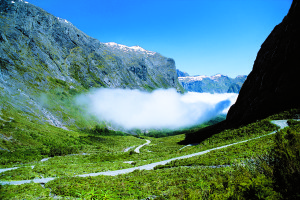
Right between Florida and California in size, New Zealand is about 1,000 miles long and divided into two main islands, North and South, by the narrow Cook Strait. The vast Pacific lies to the east, the mysterious Tasman Sea to the west and 1,400 miles farther on, Australia (though New Zealanders wish it were a lot farther). Despite their closeness the islands are quite different, as the South was formed by an immense tectonic upheaval, and the North explosive volcanic action. Don’t ask me which came first. This makes for good riding in any event (and the skiing is quite good there in winter, I understand). Coastlines are rugged, and the high Southern Alps that run the length of the South Island’s west coast tend to hold the moisture back from the rolling lowlands to the east, where you’ve never seen so many sheep. Cattle and sheep farming are big on the North Island, too, where mighty snowcapped Mount Taranaki (used as a substitute for Mount Fuji in the film The Last Samurai) is but one of many volcanoes, two still active.
It’s a wild and rugged place, and mildly eerie in the countryside because it’s all but deserted. Three quarters of New Zealand’s 3.8 million reside in busy Auckland, the largest city, and in the hip capital of Wellington, both on the North Island. Christchurch is the South Island’s largest enclave at just 330,000. Outside the cities humans are vastly outnumbered by the country’s 72 million woolies, and you may ride for quite a while without seeing a car coming the other way. And when you finally do, you may panic for a moment, wondering if in fact both of you are on the right side of the road. Meaning the left, of course—first colonized by the Brits, NZ drives on the same side as the UK and Australia.
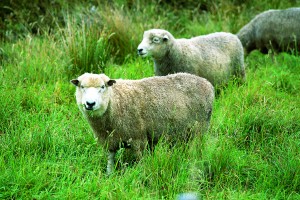
With the possible exception of skipping the far north and the Bay of Islands, I believe Edelweiss covers the best of both islands on its two-week New Zealand tour (I read a good guidebook), running groups from Auckland to Christchurch and vice versa many times in NZ’s spring and summer. In the 2006 season one tour is designated Off-Road, though in reality they all offer some optional dirt (unsealed) road sections leading to otherwise inaccessible scenery. Good reason to choose a BMW GS as your ride, the larger of the two for the road ride. It handles NZ’s endless twisties with ease, even two-up. Our tour ran from Christchurch to Auckland, and I can’t think of a reason why one direction would be better than the other.
Our morning arrival in Christchurch demanded a visit to the Britten Motorcycle Company, an easy walk into town from the hotel, with a lovely park and amazing botanical garden along the way. Christchurch is the most English of NZ cities, with gothic architecture and sculls gliding down the Avon. After paying homage to NZ inventor and entrepreneur John Britten at the tiny gift shop and museum devoted to him and the racebike of his design and manufacture, we met our group at the rider’s meeting and had dinner.
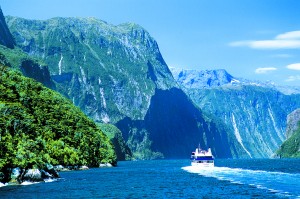
Unlike Edelweiss tours that primarily attract Americans, the NZ tour naturally draws riders from all over the world. Hong Kong, Switzerland and Germany were represented by David, Reito and Hannas, and Austria by our two experienced guides Thomas and Christian. We lucked out as our good friends Rich and Lisa joined us on this tour, taking six from California with Phil and Dawn from Modesto. All turned out to be excellent riders and fun comrades—we looked forward to every meal and conversation.
Edelweiss encourages you to ride on your own if you like, so when the rest of the group started out in the morning for an overview of Christchurch, Rich and I and our willing copilots made time for 12,349-foot Mount Cook, hoping for good photos of NZ’s highest mountain from near and far. The eastern South Island is rolling lowlands in comparison to the mountainous Alps to the west—once we left the Christchurch area on straight, flat highways connecting endless farms, the road began to twist and squirm thorough arid hills covered in knee-high grassy red tussock.
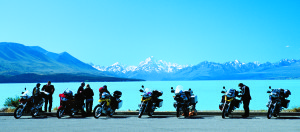
Unlike Europe, NZ has never had a war requiring strategic routes over its Alps, so the New Zealanders did the smart thing and went around. With a couple of unbelievable exceptions most of the roads skirt the foothills, creating wonderful snow-capped mountain vistas but few classic passes to “bag,” as in Europe. The way can run straight for miles, then suddenly wind along a river, through a beautiful gorge, around a lake or mountain. The only high pass road we tackled was on the way to Milford Sound in Fjordland National Park on the west side of the Southern Alps, but there are plenty of lower ones that are spectacular in this context. The Costa Rica-to-Lake Tahoe-like run from the rainforest on the west coast to the alpinelike Arthur’s Pass and back again, for example, or up the switchbacks to Cardrona Pass high above old-west Arrowtown.
More awe-inspiring than the mountains, perhaps, are the rainforests of NZ. Our route often wound along the wet west coast through green forests of palm trees and pine trees, with spring wildflowers blanketing the grassy parkways to either side. The ocean meeting the Alps makes the west coast one of the wettest places on earth, creating a dense jungle playground for Ma Nature. At one photo stop in the rainforest I took off my helmet and removed my earplugs, and was shocked by the deafening roar of the birds and cicadas. Penguins and possum and gangster-like kea birds (that given the chance will eat your motorcycle’s seat) flourish on the west coast with sand flies in places, which are only a nuisance at stops if you forget the insect repellant.
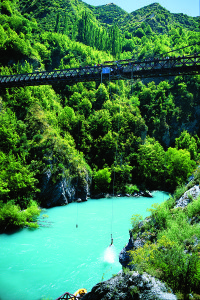
Turquoise lakes, waterfalls, deserted beaches piled with driftwood, mid-morning coffee stops with the group—the good memories are endless from this tour. One night we stayed with a family at a working deer farm, feeding the deer, riding ATVs, learning about the stag’s aphrodisiac antlers (velvet) and eating venison, while others in the group went to a sheep farm and were put to work shearing a few woolies. The ride across Cook Strait to the North Island on a large ferry was simple and scenic upon arriving in Wellington harbor, timed well for a happening weekend night in this bohemian city.
NZ is the home of extreme sports, and a few in our group shelled out $120-$150 for a bungee jump or jet-boat ride, for which our guides made plenty of time and opportunities. The country’s slowly receding but still amazing glaciers—Fox and Franz Joseph—just off the west coast road can also be seen and even landed upon by helicopter, which several in our group enjoyed.
We chose to spend our two rest days riding, the first from lively Queenstown with its beautiful lake to Milford Sound and back, a long ride but the only practical way to see this pretty fjord on the west coast carved out by numerous glaciers. On the other rest day in Wellington, Genie shopped while I rode up to the Southward automotive and motorcycle museum a few miles to the north with some of the group, the largest museum of its kind in the southern hemisphere. Our favorite day, however, was the ride up Coronet Peak and then down into Skipper’s Canyon just north of Queenstown on a narrow, winding dirt road, where much of the first Lord of the Rings movie was filmed. Waiting for us at the bottom was a tasty picnic barbecue arranged by our guides at a 320-foot outback bungee and lodge alongside the dramatic canyon, a narrow ribbon of turquoise snaking along the bottom.
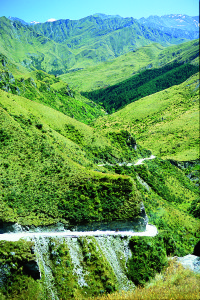
Though no fault of Edelweiss—the NZ diet is British-influenced, after all—the only lasting memory I have of the food
on the tour is this barbecue and the green lip mussels commonly served for lunch and especially good in Picton. I also enjoyed the plentiful lamb dishes, but like the Brits, New Zealanders tend to like most things fried or covered in sauce, and salads are what food eats. We usually dined at the hotels, three of which merely met our expectations, but the rest greatly exceeded them. If we had a gripe about anything on the tour it would be the consistently early dinner reservations—the few times they were later it was a relief not to have to rush to get ready.
The North Island is more pastoral than the rugged south, yet still has more than its share of wonderful winding roads. We got our first real taste of the country’s native Polynesian culture here at a Maori concert one evening, pressing noses and such, and our co-pilots enjoyed wine tasting in the world-famous-in-New Zealand Hawkes Bay vineyard area. We had a tough decision to make one day between riding the Thermal Highway between Napier and Rotorua or tackling the longer, partly dirt route though the scenic Te Urewera Forest. If you haven’t been to Yellowstone, the boiling pools, thermal springs, geysers and fumaroles in the parks dotted along the Thermal Highway will seem quite otherworldly, and taking this easier route will conserve your energy for the long ride ahead around must-see Coromandel Peninsula. If you’ve seen Old Faithful and the rest, however, by all means make the Te Urewera loop. Those who did arrived tired but beaming in Rotorua.
We covered about 2,100 miles on this tour of sometimes subtle, sometimes magnificent but always constant beauty. Overall I’d say the EBT New Zealand tour should be on your short list of foreign motorcycle tours, perhaps even worth doing before the Alps in Europe. From having your bags waiting for you in your room each night, to the experienced guides who know the best roads and area history, to the well-kept bikes, New Zealand with Edelweiss is just plain awesome. We loved it and would do it again in a heartbeat—maybe Auckland to Christchurch next time.
NZ with EBT
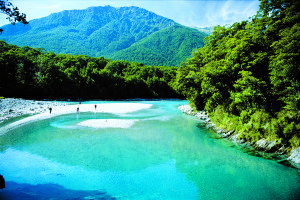
Riding on the left, the must-see offroad sections, grit left over from winter in some of the corners and potentially wet roads put this tour in the intermediate-and-up skill category. Two additional challenges confront prospective New Zealand tourers. First is the flight—L.A. to Auckland is about 13 hours, New York-Auckland—well, forever. On the way you cross the international date line, though, so the time change in hours is small…except that it’s tomorrow. Just try not to think about it too much and have another flat white (a NZ cappuccino).
The other hurdle is costs. Although the New Zealand dollar runs about $.75, prices for gasoline, food and drink are higher there to start with. A simple lunch for two and gas each day ran $50-$60 U.S. This is neither EBT’s cheapest tour, nor its most expensive. Two-up on a BMW R1200GS at this writing was $4,640 per person, though a solo rider willing
to share a room and wring the neck of an F650GS chain-drive single could do it for $4,550. Neither cost includes airfare. Our tour included motorcycle rental, hotels and farm stay, breakfast every day and three picnic lunches, dinner
every evening except on the two rest days (we liked “Chow” in Wellington), airport transfers, one guide on a bike and one in the luggage van, tour book and maps (good ones).
Edelweiss uses Kea Motorcycles for its BMW rental bikes in New Zealand, and both companies say Kea replaces the bikes every season. Our group’s motorcycles were all in new or excellent condition and all had luggage.
The prepaid rental contract contract is actually with Kea, which gave us three choices for damage insurance at the start of the tour: $30 per day, complete coverage with no deductible; $15 per day with a $1,500 deductible; or a $3,000 deductible deposit on a credit card, all of which is refunded if there is no damage. Consider the four-bike domino tipover our group had waiting for the ferry in Picton, and make your choice. I went for the $300 so I wouldn’t have to worry; Rich put down the $3,000 deposit because despite appearances he’s really an optimist. And he got it all back—his bike wasn’t in the domino.
Two NZ tours are scheduled for October-November 2005 and four in January-March 2006. For more info see www.edelweissbike.com or contact Tri Community Travel & Cruises, P.O. Box 1974, Wrightwood, California 92397-1974; (800) 507-4459; edelweiss@trict.com.
(This article Land of the Long White Cloud was published in the August 2005 issue of Rider.)







